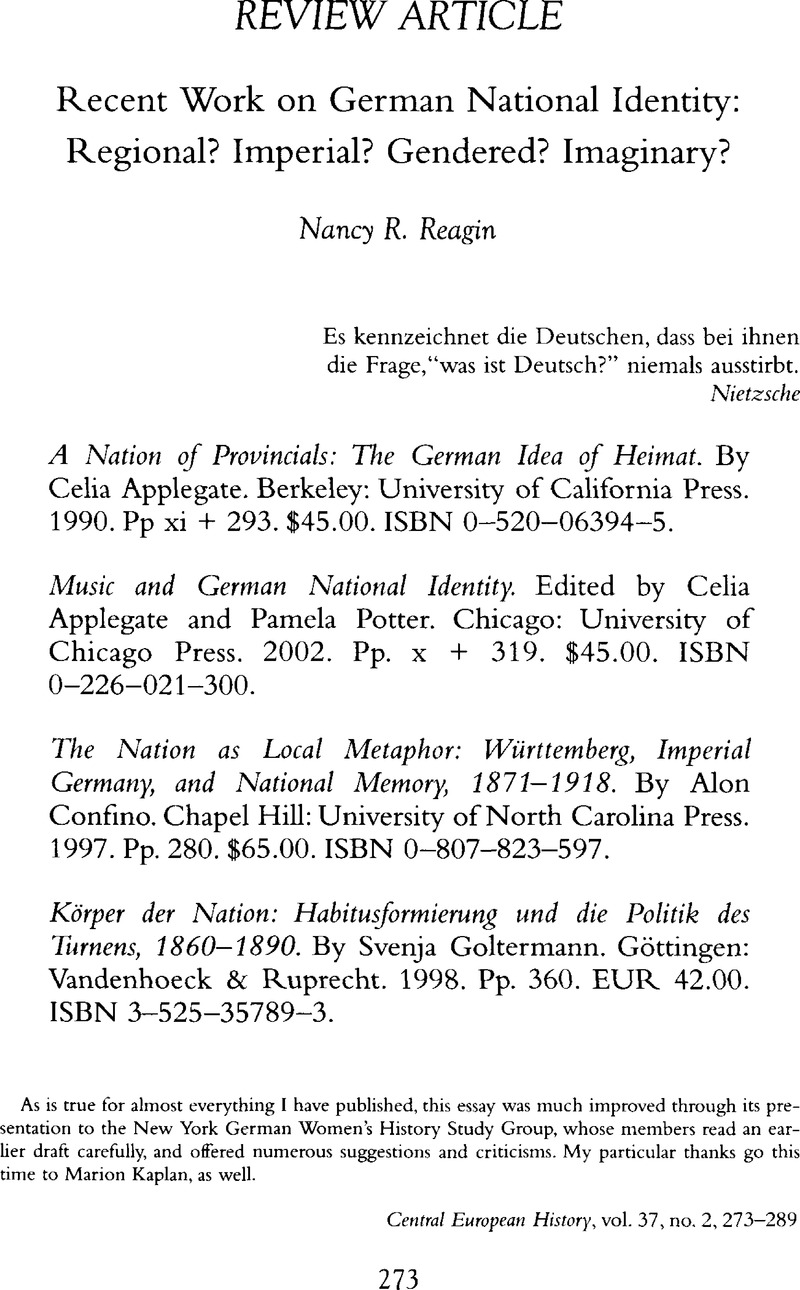Article contents
Recent Work on German National Identity: Regional? Imperial? Gendered? Imaginary?
Published online by Cambridge University Press: 16 December 2008
Abstract

- Type
- Review Article
- Information
- Copyright
- Copyright © Conference Group for Central European History of the American Historical Association 2004
References
1. Anderson, Benedict, Imagined Communities: Reflections on the Origins and Spread of Nationalism, (revised ed. New York, 1991).Google Scholar
2. Vanchena's book also discusses the creation and popularization of better-known poems and songs, such as “Die Wacht am Rhein” Her analytical framework could be more sophisticated, but her study includes one extremely attractive feature: an attached CD that includes the texts of hundreds of these songs and poems in their entirety, with a detailed and clever set of indexes designed to be used to search these texts by author, content, metaphor, location, etc. The CD alone will justify the purchase price for many university libraries, since it provides an extremely useful set of primary sources, which could be used in teaching.
3. The imperial government was not able to make use of songs that came from the “wrong” class, as well as those from the wrong side of the German-Austrian border. Vernon Lidtke's research on songs that were popular among the working class during the imperial period shows that workers' songs were sometimes “patriotic” (in a broad sense) but also espoused values of democracy and equality that put them at odds with the government. Such songs were also excluded from official usage or acknowledgement. See Lidtke, Vernon, The Alternative Culture: Socialist Labor in Imperial Germany (Oxford, 1985), 124–27.Google Scholar
4. This comment about the “empty” nature of Heimat iconography is strongly supported in one of the best chapters in Applegate and Potter's collection, an essay by Philip Bohlman on the history of the Landschaftliche Volkslieder editorial production project, a 44 volume series that focuses on the folk songs of each “German” region. Bohlman notes that although each volume was formally concerned with a very particular locality and dialect within German-speaking Europe, in practice the editors chose to present all the songs in high German, and in such a way that the various Heimate tend to blur together in a “timeless” iconography: “all the usual folk-song genres are present in volume after volume: songs of the homeland or Heimat; historical songs; songs about hunters, peasants, and soldiers; songs about the nobility and landowners; songs about monuments and memory … The folk songs are secure, even frozen, in a timeless, mythological world.” Applegate, and Potter, , Music and German National Identity, 119–20.Google Scholar
5. Leora Auslander, who is currently working on a comparative history of consumption and the role of the state in early twentieth-century Germany and France, has also noted the ways in which the Heimat and provincial identities are particularly intrinsic to German national identity, which she argues formed a sharp contrast to the construction of French national identity. See Auslander, , “‘National Taste?’ Citizenship Law, State Form, and Everyday Aesthetics,” in The Politics of Consumption: Material Culture and Citizenship in Europe and America, ed. Daunton, Martin and Hilton, Matthew (New York, 2001), 117–18. A more interesting comparison to Germany's construction of national identity might be Italy. Italy's strong regional loyalties and cultures (which to this day often supercede identification with the nation as a whole) and its late national unification would seem to make it an even more fruitful choice than France for a comparative study with Germany that focused son national vs. local or regional identities.Google Scholar
6. Any discussion of the history of masculinity in German culture must now include Hagemann's, Karen magisterial Habilitationsarbeit, “Männlicher Muth und teutsche Ehre”: Nation, Krieg und Geschlecht in der Zeit der antinapoleonischen Kriege Preussens (Paderborn, 2002). Her monograph focuses on a much earlier period than the other studies discussed here, and for that reason, I have not included it. It is indispensable, however, for any work on the history of citizenship and the nation in Germany.Google Scholar
7. See Smith, Helmut Walser, German Nationalism and Religious Conflict: Culture, Ideology, and Politics, 1870–1914 (Princeton, 1995)CrossRefGoogle Scholar and his edited anthology, Protestants, Catholics and Jews in Germany, 1880–1914 (New York, 2002).Google Scholar
8. Quoted in the chapter on Imperial Germany written by Kaplan, in Kaplan, Marion, ed., Jewish Daily Life in Germany, 1650–1945 (forthcoming).Google Scholar
9. Chickering, Roger, We Men Who Feel Most German: A Cultural Study of the Pan-German League, 1866–1914 (Boston, 1984).Google Scholar
10. Examining popular reception of the efforts to promote loyalty to a particular regional dynasty, or the popularity of a particular monarch, would indeed be a challenge, and an interesting research topic. Popular attachment to local rulers would appear to have declined during the Kaiserreich (along with the popularity of particularist political parties), at least to judge by the rapid collapse of all these regional dynasties in November 1918. Almost no one seems to have defended them, although this might be yet another result of Germans' widespread war-weariness and sufferings, which led to the discrediting of almost all authority figures. Regional rulers might therefore have continued to enjoy broad support in some areas up through 1914.
11. For a discussion of the 1913 citizenship law, the varied communities of ethnic Germans abroad, and metropolitan Germans' fascination with the Auslandsdeutschen, see Nancy Reagin, “German Brigadoon? Domesticity and Metropolitan Perceptions of Ethnic Germans in Eastern Europe During the Interwar Period,” paper given at conference on “The Heimat Abroad: The Boundaries of Germanness,” at the Center for European Studies, New York University, 19–20 November, 1999. See also O'Donnell, Krista, Bridenthal, Renate, and Reagin, Nancy, eds., The Heimat Abroad: The Boundaries of Germanness (University of Michigan Press, forthcoming).CrossRefGoogle Scholar
- 6
- Cited by




